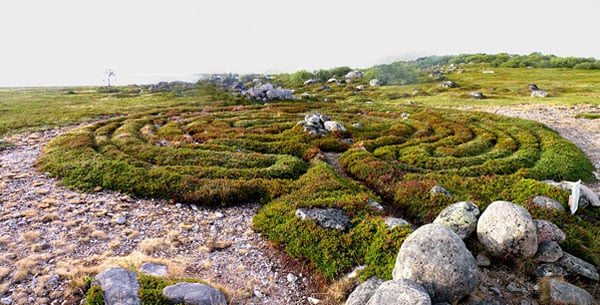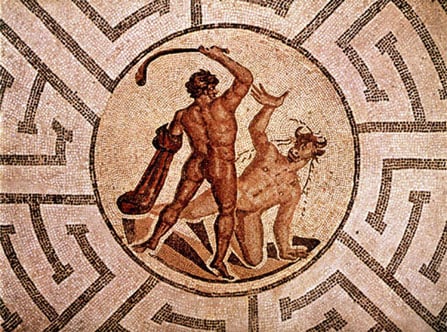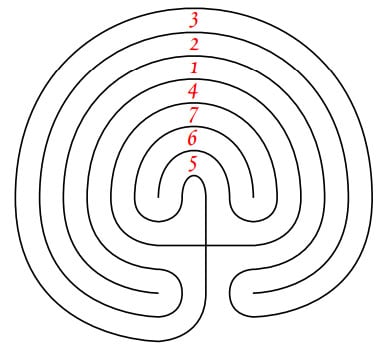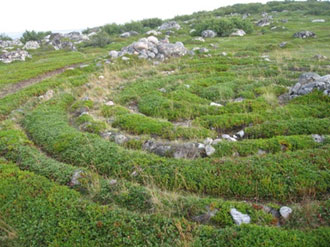One of the stone labyrinths on Bolshoi Zayatsky Island.
On a small collection of remote islands in the White Sea of Russia lies the highest concentration of ancient labyrinths on the planet. Despite numerous theories, archaeologists and historians have not come to any agreement about why they were built and what their purpose was. The labyrinth remains one of the most mysterious symbols found on Earth – thousands of years ago, it appeared at the same point in history on all inhabited continents in the world – why?
Today, we use the term ‘labyrinth’ to refer to any maze-like structure. However, there is a key distinction between a labyrinth and a maze. A maze refers to a complex branching (multicursal) puzzle with choices of path and direction; while a labyrinth is a single-path (unicursal) pattern that has only a single, non-branching path, which leads to the centre.
The long history of the labyrinth
The word ‘labyrinth’ comes from the ancient Greek words ‘labrys’, a word for the iconic ‘double axe’ which was used by the Minoans on the island of Crete, and ‘inthos’ meaning ‘place’. Thus, labryinthos has been interpreted to mean ‘house of the double-headed axe’. The complex palace of Knossos in Crete is usually implicated. According to Greek mythology, King Minos of Crete had the craftsman Daedalus construct the labyrinth in order to conceal the Minotaur, the half-bull, half-human offspring of Minos' wife Pasiphae and a bull. For some unknown reason, Daedalus and his son Icarus were confined in the labyrinth. Constructing wings of feathers and wax, the two were able to escape by flying above the walls of the labyrinth. Young Icarus, however, impetuously flew too near the sun. His waxy wings melted and he drowned in the Icarian Sea. While the legend of the Minotaur was long thought of as a myth, the remains of the labyrinth of Knossos were uncovered in the early 20 th century by archaeologist Sir Arthur Evans.
An ancient mosaic depicting the labyrinth of
Knossos and the Minotaur
Although there are numerous labyrinth designs found throughout history, such as the seven circuit, eleven circuit, and twelve circuit labyrinths, in Greece and throughout the Mediterranean, a common symbol of a 7-circuit labyrinth was associated with the legends. Known today as the Cretan labyrinth, it consists of a single path winding back and forth to a centre point in a series of seven concentric rings. Intriguingly, the shape of the 7-circuit labyrinth also mirrors the motion of the planet mercury in the sky over a long period of time. Did some ancient astronomer record this motion, and create the labyrinth symbol based upon it? We will probably never know. The earliest known use of the 7-circuit labyrinth symbol occurs on a clay tablet from the Mycenaean palace at Pylos in Greece. A fire destroyed this palace around 1200 BC, baking the clay tablet and preserving it for archaeologists.
A depiction of a seven circuit labyrinth
While the word ‘labyrinth’ is closely tied in with Greek history and mythology, labyrinths have been around a lot longer than the legend of Knossos and the Minotaur. Dating back nearly 4000 years is the famed labyrinth of antiquity, the Egyptian temple precinct of a pyramid complex of many courts, built at Hawara by Amenemhet III of the 12th Dynasty (1844-1797 BC). There were twelve separate courts of considerable size all facing one another throughout this labyrinth and all connected by corridors and colonnades and shafts. Criss-crossing alleys and false doors sealed by stone plugs all protected the central burial chamber of the pyramid of the king.
But the labyrinths of Greece and Egypt are just the tip of the iceberg. Labyrinths have been found in just about every major religious tradition in the world, have formed an integral part of many cultures, and have been found on every inhabited continent. At about the same time as the appearance of the Greek labyrinth, an essentially identical pattern appeared in Native American culture, the Tohono O'odham labyrinth, which features I'itoi, the "Man in the Maze". A prehistoric petroglyph on a riverbank in Goa shows the same pattern and other examples have been found among cave art in northern India and on a dolmen shrine in the Nilgiri Mountains. In terms of ancient archaeological monuments, more than 300 examples of labyrinths can be found in various locations around the world. Many questions remain around how the same pattern managed to appear at the same time in apparently disparate cultures.
While recorded history links the creation of labyrinths to a period beginning around 4,000 years ago, the earliest labyrinths are much older than that and first appeared in Neolithic rock carvings and stone formations concentrated around Europe, Scandinavia, and Russia.
The labyrinths of Bolshoi Zayatsky
The Solovetsky Islands (or Solovki), are an archipelago located in the Onega Bay of the White Sea, Russia. It is here where there can be found thirty-five Neolithic labyrinths, known as ‘vavilons’ (‘Babylons’) in the local dialect, which date back to around 3,000 BC. The most remarkable are the stone labyrinths of Bolshoi Zayatsky Island, a group of fourteen labyrinths in a 0.4km 2 area. They are particularly well preserved and have been documented and speculated about, without any definite conclusions being reached as to their purpose.
In addition to the labyrinths, as many as 850 heaps of boulders have been found on the island, many containing bone fragments. Other stone formations discovered on the island include a representation of the sun, complete with radial spokes. It is generally agreed that these ancient labyrinths and stone formations were related to spiritual beliefs, and may have symbolized a border of sorts between the material world and the underworld – the mythical abode of the dead.
The labyrinths are constructed from boulders placed on the surface of the ground, and it has been determined that these boulders were gathered locally. The smallest labyrinth measures around six meters in diameter, with the largest being 25.4 meters in diameter. The rows of boulders form spirals, with some consisting of two spirals, described as resembling two serpents with their heads in the centre. The entrances to the labyrinths are mostly on the south and while there are five different settings, they each have only one entrance/exit point. All the labyrinths on Bolshoi Zayatsky are found on the western side of the island, while the eastern part of the island features a significant collection of stone formations, but no labyrinths. Although the labyrinths have become quite overgrown with the island's shrub-like vegetation, their shapes remain clearly visible.
One of the stone labyrinths on Bolshoi Zayatsky Island
Why were the labyrinths of Bolshoi Zayatsky built?
Many hypotheses have been put forward to explain why the Neolithic settlers of the Solovetsky Islands went to the considerable effort of constructing numerous stone labyrinths.
In the 1970's, the predominant hypothesis, advanced by N. Gurina, was that the labyrinths were built as traps for fish. Evidence comes from the fact that all of the labyrinths in the region were built close to the sea and water levels were much higher 5,000 years ago, when it is believed they were constructed. The fish would have swum in through the entrance and become trapped in the labyrinth, making it easier for fisherman to retrieve their catch. However, the major flaw in this argument is that numerous labyrinths have been found inland throughout the world.
Researcher L. Ershov had a different theory. Ershov maintained that within the lines of labyrinths was the schematic reflection of both the sun's and moon's orbits, thus the labyrinths were used as calendars. However, this has been debated on the basis that labyrinths do not have a consistent direction of entrance.
One theory popular today, particularly among esoteric circles, is that a labyrinth is an ancient symbol that relates to wholeness. It combines the imagery of the circle and the spiral into a meandering but purposeful path. It represents a journey to our own centre and back again out into the world. Walking the labyrinth can be considered an initiation in which one awakens the knowledge. It is believed that walking the path of the labyrinth brings about a change to one’s state of consciousness and the perception of time and space. Indeed, Vlad Abramov, a researcher who explored the labyrinths of Bolshoi Zayatsky, described the surreal experience of walking the twisting and turning paths of the labyrinth.
"After entering a labyrinth and circle several times around the centre you leave it through the same entrance. Just after several turns it becomes unclear how much you have walked and how much more to walk. Subjectively, the time stops, but by watch the great labyrinth is passed in 15 minutes. It is difficult to think about something collateral; the path is narrow and you are required to look permanently underfoot. The path is twisting clockwise and anticlockwise. At last – the exit; and you are happy that the journey is over."
Despite the theories presented above, and numerous others, the accepted theory today, and one which has been put forward by Carl Schuster and Edmund Carpenter, is that the construction of the labyrinths was linked to religious beliefs. Prehistoric labyrinths are believed to have served as traps for malevolent spirits, as defined paths for ritual dances, and/or as a symbol for the barrier between this world and the underworld. It is speculated that the labyrinths may have been included in rituals to assist the souls of those who have died to cross over to the underworld.
Archaeologist A.L. Nikitin suggests that labyrinths, as indicated in legends, point the way to the ‘entrances’ and ‘exits’ of a subterranean kingdom which could be opened only by those who knew the ‘magic key’ to this back door.
This suggestion is consistent with widely held belief among prehistoric cultures in the theory of ‘Three Worlds’, according to which ancient people thought that the Universe was separated into a Lower World, where souls of the deceased would go after death, the Middle World, consisting of the physical plane of existence, and the Upper World of the stars, clouds, and gods.
To this day, the far northern islands of Russia continue to beckon curious travellers and scholars, eager to solve the mystery and the true meaning of the labyrinth.
Source: http://www.ancient-origins.net/ancie...573?page=0%2C2
peace...








 Reply With Quote
Reply With Quote
Bookmarks